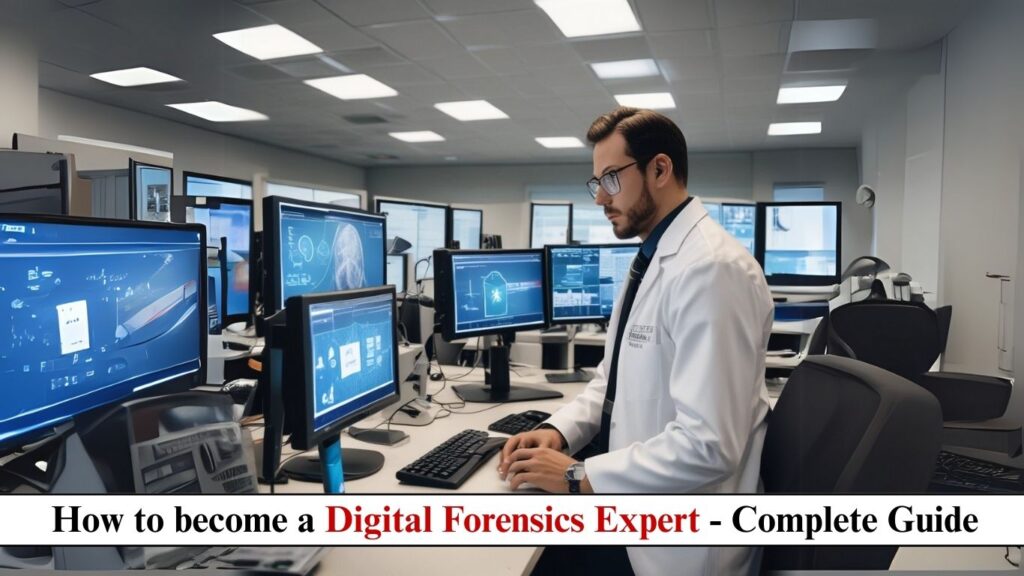
Introduction to Digital Forensics
The global digital forensics market is projected to reach $23.5 billion by 2030, fueled by rising cybercrime and data privacy regulations. Digital Forensics Experts serve as cyber detectives, uncovering digital evidence from devices, networks, and cloud environments to solve crimes, investigate breaches, and support legal proceedings.
This guide covers:
- Evolution of digital forensics
- Salary ranges worldwide
- Key responsibilities
- Required technical skills
- Certification pathways
- Future industry trends
Whether you’re an IT professional, law enforcement officer, or cybersecurity specialist, this guide provides actionable steps to enter this high-demand field.
History of Digital Forensics
Early Days (1980s-1990s)
- 1984: FBI creates Computer Analysis and Response Team (CART)
- 1991: First forensic data recovery tools developed
- 1999: NSA publishes first forensic guidelines
Standardization Era (2000-2010)
- 2002: SANS Institute launches forensic certification programs
- 2005: US adopts Federal Rules of Evidence for digital data
- 2008: iPhone sparks mobile forensics specialization
Modern Challenges (2011-Present)
- 2013: Snowden leaks drive encryption forensics
- 2017: GDPR creates forensic data compliance requirements
- 2023: AI-generated deepfakes require new authentication methods
- 2024: Quantum computing threatens current forensic techniques
Digital Forensics Expert Salary (2024)
| Experience Level | Average Salary (US) | Industry Variations |
|---|---|---|
| Entry-Level (0-2 yrs) | $65,000-$90,000 | +30% in government |
| Mid-Career (3-5 yrs) | $90,000-$130,000 | +40% at consulting firms |
| Senior (5+ yrs) | $130,000-$200,000 | +50% for expert witnesses |
Specialty Premiums:
- Cloud forensics: +$20,000
- Mobile device analysis: +$15,000
- Cryptocurrency tracking: +$25,000
Roles & Responsibilities
1. Evidence Acquisition
- Create forensic images of storage media
- Implement chain of custody protocols
- Preserve volatile memory (RAM captures)
2. Data Recovery & Analysis
- Recover deleted files (file carving)
- Decrypt protected containers
- Analyze metadata and timestamps
3. Incident Response
- Identify indicator of compromise (IOCs)
- Trace attack vectors
- Document timelines of intrusion
4. Legal Support
- Prepare court-admissible reports
- Testify as expert witness
- Maintain evidence integrity for trials
5. Tool Development
- Build custom scripts for analysis
- Adapt to new file systems
- Reverse engineer malware artifacts
Required Qualifications
Technical Skills Matrix
| Category | Essential Tools |
|---|---|
| Disk Forensics | FTK, EnCase, Autopsy |
| Memory Analysis | Volatility, Rekall |
| Mobile Forensics | Cellebrite, Oxygen |
| Network Forensics | Wireshark, NetworkMiner |
| Cloud Forensics | AWS/GCP/Azure tools |
Certification Pathway
- Entry-Level:
- CompTIA Cybersecurity Analyst (CySA+)
- GIAC Certified Forensic Analyst (GCFA)
- Mid-Career:
- Certified Forensic Computer Examiner (CFCE)
- EnCase Certified Examiner (EnCE)
- Advanced:
- GIAC Certified Forensic Examiner (GCFE)
- Certified Cloud Forensics Expert (CCFE)
How to Get Started: 5-Step Roadmap
Step 1: Build Foundational Knowledge
- Complete SANS FOR500: Windows Forensic Analysis
- Master Linux command line for analysis
- Study file systems (NTFS, APFS, EXT4)
Step 2: Gain Practical Experience
- Entry-Level Roles:
- IT Support Technician (focus on security)
- SOC Analyst with forensic duties
- Hands-On Labs:
- TryHackMe Forensics Rooms
- Magnet Forensics Virtual Cases
Step 3: Specialize
- High-Demand Niches:
- IoT device forensics
- Blockchain investigation
- Vehicle infotainment systems
Step 4: Earn Certifications
- Start with CySA+ or GCFA
- Progress to vendor-specific certs (Cellebrite, Magnet)
- Consider law enforcement training if applicable
Step 5: Target Employers
- Law Enforcement: FBI Cyber Division
- Private Sector: Kroll, Mandiant, PwC Forensics
- Corporate: Fortune 500 incident response teams
Future Scope & Trends
1. Emerging Challenges
- 2025: AI-generated evidence authentication
- 2027: Quantum-resistant forensic techniques
2. New Specializations
- Metaverse crime investigation
- Neural implant forensics
- 5G network analysis
3. Market Growth
- 300% increase in cloud forensics demand
- $100B+ in cryptocurrency needing tracking
4. Career Innovations
- Digital Forensic AI Trainers
- Cyber Insurance Investigators
- Automotive Black Box Analysts
Conclusion: Is This Career Right For You?
✅ Ideal Candidate:
- Detail-oriented problem solver
- Passion for both tech and justice
- Comfort with legal processes
🚀 Action Plan:
- Master disk and memory forensics
- Build home lab with write blockers
- Network at DFRWS conferences
- Specialize in one forensic domain
With cybercrime damages projected to hit $10.5 trillion annually by 2025, forensic experts will remain in critical demand worldwide.
Want our free forensic investigation checklist? Comment below!
Questions about law enforcement vs corporate paths? Ask here!













Post Comment